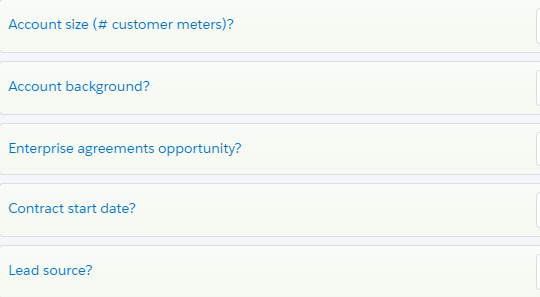
White Rock recommends 8 Salesforce must have configuration features that are highly effective in any organization for your customer. Of course, there are hundreds of “must have” features that can be listed. However, these are the ones we believe change the culture for your team and customer quickly.
Organizations that are focused on their customer experience and revenue growth should treat the CRM system as a cornerstone tool. In other words, CRM is just as important as the accounting system or the product/service delivery system. The best CRM strategy will incorporate our “must have” critical features as soon as possible. In practice, many times these features have to be added over time. The reasons for this continuous improvement methodology are numerous. Cost, ability to incorporate, and training are just a few of the reasons that might slow the adoption of the critical CRM features we recommend.
Take a dive into the details of the most impactful Salesforce CRM features.
#1 Contact Management
Contact management is first among the 8 Salesforce must have configuration features. Salesforce provides easy customization for contact management. This feature allows for the ability to capture the right information about a person and company. Just as critical is NOT capturing irrelevant information. In fact, we find that customers create too many fields thus your sales team either will not complete the information or will spend too much time trying to capture information that is not purposeful. Here are some keys to success for effective contact management.
Enable Salesforce Maps and Location Services
Salesforce provides a great feature that uses Google Maps to display maps on standard address fields, enables creation of Visualforce maps, and helps users enter an address with auto complete for faster input and less keystrokes.
Salesforce Account and Contact Related Activity
Capturing activity that takes place with people and organizations is vital for history and reporting. Just as important is having a field setup on the contact or account record that provides a category of the activity. Examples of activity types are Call, Meeting, Research, and Other. Why is this important? First, categorizing your activity creates a timeline of interaction. Further, when configured to work with other fields related to activity like Due Date, Reminder, and Notes on the activity, a full timetable of activity content tells the story in detail. Last, minimizing the fields is important along with using picklist fields where possible to speed up data entry and reduce keystrokes for the user.
Capture Campaign Metrics Related to Your Contact
Salesforce has an enormously powerful relationship between Contact and Campaign. Campaigns can be used to track marketing activities like email, webinars, ads, trade shows, and more. When campaigns are setup in Salesforce, contacts can be enrolled as members then tracking statistics about their reactions can be displayed on the Contact record page so that users can see who is showing the most interest at any given time.
Create Opportunities directly for Accounts
Opportunities are deals in progress. Opportunity records track details about deals, including which accounts they are for, who the players are, and the amount of potential sales. Thus, opportunities should be created directly for accounts you’re working.
As your deals progress toward the Proposal stage:
- Add products and attach files, such as contracts or data sheets.
- Log the calls you make.
- Use Notes to jot down things during customer meetings.
- Create tasks for key activities and calendar events for client meetings.
- Send email to the opportunity contact or other key decision-makers.
#2 Develop a Consistent Sales Process with Progress Stages
Knowing what needs to be done at each stage of the sale gives sales reps a huge advantage over salespeople who wing it every time out. Without clearly defined steps and milestones that guide sellers from prospecting to the sale, even the most promising deals can slip away due to unorganized methods. The customer will feel it too.
Define the Sales Process
A sales process is a set of repeatable steps that a salesperson takes to advance a prospective buyer from the early stage of awareness to a closed sale. Typically, a sales process consists of 5-7 steps. Defining your stages is critical to:
- Accurate sales forecasts
- Creating a buyer’s journey that is organized
- Onboarding new sales team members
- Refining the process to be more effective over time
How does the sales process in Salesforce benefit the sales team and customer?
To grow your business, you need to have a robust method for tracking your sales pipeline. Salesforce handles this very well. The ability to customize this process is undoubtedly one of the top 8 Salesforce must have configuration features.
The benefits are:
- Capture the whole customer journey
- Save time through powerful reporting and easy input
- Improved customer experience, communication, and service
- Accountability of sales progress over the life of a deal
Accurate Forecast of Revenue
Of all the features in Salesforce, the most critical from our view is an accurate sales forecast that can be relied upon. How many times have you asked for next quarter’s sales forecast then learn it is wrong?
#3 Daily Dashboard
The daily dashboard allows you to see a general or detailed overview of company performance in real time. The dashboard is the control panel to your business. This tool is used to help organizations quickly identify workplace statistics based on KPIs. By allowing users to easily visualize and review data immediately, dashboards increase the overall efficiency of business analytics.
Coaching and Collaboration Aid to Sales Management
Great sales coaching requires great, accurate real-time data. According to the HBR, the most effective coaching is with the middle 60% of the sales team. Therefore, it is imperative to have an effective daily dashboard system to help them.
Enable Leadership to Understand Performance for Decision Making
CEOs are busy. The ability to surface key performance insights is critical. Here are 5 critical daily dashboards for CEOs:
- A Lead Funnel Dashboard
- The Revenue Forecast Dashboard
- The Sales Leader Dashboard
- The Executive View Daily Dashboard
Provide your Sales Team with Information to Better Serve
Sales teams need to collaborate and deliver organized journeys for buyers. Dashboards provide that real time information to be responsive and responsible to your customers. Dashboards will facilitate faster decision making and organized teams.
#4 Salesforce Automation
Automation refers to the design and configuration used to automate the business tasks such as inventory control systems, account management, process management, contact management, customer tracking, sales funnel management, sales forecasting analysis, product knowledge, sales lead tracking systems, and sales team performance evaluations. Salesforce is the leading platform for automating business processes in all these categories. Automation is never ending and always evaluated for continuous updates into perpetuity. Further, Salesforce automation is nearly limitless. Of the 8 Salesforce must have configuration features, this is the one that speeds up your business processes and saves time.
Web to lead
Salesforce lets you easily create web-to-lead forms that capture information about visitors to your website. The information is automatically stored in new lead records in your Salesforce sales system, and the lead can then be scored, qualified, and routed to sales reps.
Web to Case
Gather customer support requests directly from your company’s website and automatically generate up to 5,000 new cases a day with Web-to-Case. This feature can help your organization respond faster and improve your support team’s productivity.
Approvals and Notifications
An approval process automates how records are approved. An approval process specifies each step of approval, including from whom to request approval and what to do at each point of the process while notifying the user along the way.
#5 Mobility
There is only so much that the desktop version of Salesforce can do for you if you are not confined to the office, especially if you have active sales and support teams who spend most of their work hours in the field. CRM with the Salesforce Mobile App is a great tool for these sales warriors. Without a solid mobile configuration, your organization is missing out on one of the keys of the 8 Salesforce must have configuration features.
Timely Data Entry
Who wants to be out in the field all day, making calls, providing demos, and closing deals then have to enter all of your activity at the end of the day? Salesforce Mobile App allows account, contact, and opportunity updates throughout the day regardless of where you may be. In an area with no Internet access? No problem, once your access is reestablished, your information will automatically sync up to the database.
Talk to text entry
Take advantage of the iPhone Talk to Text or Einstein Voice feature with Salesforce Mobile App. Dictate your notes, activities, and deal updates while driving to your next appointment.
Planning your day on the run
Stay up to speed by planning your day while on the run with Salesforce Mobile App. Use the Salesforce Mobile App to:
- Personalize and plan your daily demos and pitches to customers
- Stay logged in all the time saving time logging in and out
- Study your daily dashboard in Salesforce to review performance and know your next steps.
#6 Integration with marketing platform
The data will not lie: Integrating your marketing platform with Salesforce can help businesses realize increased marketing ROI and overall growth. More specifically, how can integration marketing with Salesforce benefit your business? Let’s start with lead generation.
Lead Generation
Lead generation is an extremely important step in any business’ growth. Integration provides your sales team more insight into what materials the lead became interested in and how that lead entered the pipeline. Therefore, automating the process between marketing and Salesforce can also give you a richer, more detailed picture of potential customer behavior.
Sales and Marketing Accountability Alignment
Smarketing. A buzz word for sure but it speaks to the importance of alignment between sales and marketing. When sales teams know where their leads are coming from and more importantly not coming from then sales can collaborate more objectively about improvements. Conversely, if marketing is delivering high quality leads to the sales team yet growth and close rates are not on the rise, then marketing has an objective stance to collaborate with the sales team to improve.
Bring the Analytics Together
The insights delivered from your marketing platform, Google Analytics, Google Search Console, and Salesforce when integrated are remarkable. The power of the story told about the journey of your buyer is crisp and clear. The benefit of having all of this data show on the contact page in Salesforce allows the user to understand the path taken by their customer which delivers impactful decision making about where to market, what the message should be, and who to target. Thus, the cost of customer acquisition becomes optimized more and more over time.
#7 Integration with accounting system
Want to run your business more strategically and proactively? We offer Accounting Seed, an innovative, robust financial software solution that transforms the way you do accounting. It’s flexible, collaborative, connected, and trusted.
A True 360⁰ View of the Customer
As an Accounting Seed Partner, White Rock can move you from the traditional, rigid accounting systems by linking your mission-critical CRM application, banks, business processes, and financial data together for end-to-end visibility of your customer data.
Cash Flow Projections
The ability to have cash flow projections related to the timing of closed sales and customer payments is critical. Therefore, using the information about an account in Salesforce with the financial information in Accounting Seed delivers a seamless, easy-to-use cash projection without leaving Salesforce. The result is error free analysis.
Safeguard Accounting Records
Accounting Seed is the most secure, reliable API in the industry. Further, utilizing Salesforce and Accounting Seed will help drive faster decisions, better productivity, while automating many of the redundant steps.
#8 Integration of Outlook or GSuite Email and Calendar
This feature is listed as #8 on the list but is the #1 integration that we start with for customers. Having the ability to access Salesforce while working in your Outlook or Gmail email client provides the ability to add email records easily to your contacts and other related Salesforce information. Given the automation capabilities of Salesforce, there are no limits to the richness of the information and ease to lookup, search, and analyze the progress that is made with your customers.
Speed up your day
We have helped customers who would literally copy and paste emails into Salesforce to have that information that is vital in an email. Thus, having your emails and calendar integrated with Salesforce will save you countless hours during a year’s time.
Know the Customer’s Journey in One Place
Having your calendar events and emails associated with your accounts and contacts in Salesforce provides the full picture of the story line that evolves with your prospects and customers. Vitally important is what our customers tell us.
Stay organized
The ability to organize your day and plan for the next day is where integrating your Outlook or GSuite and Salesforce will boost your productivity immediately. Plus, having this information always available will let the user access it via Salesforce Mobile App and from any other device any time.
Creating a functional and fully integrated CRM system is not an easy task, however, it is a vital investment. Creating relationships with customers is a paradigm shift that moves a company from the middle of the pack to the top of their respective industry. An effective CRM strategy helps companies work with the customer and try to understand them instead of blindly sell their product or service.
Do you want to discuss how these 8 Salesforce must have configuration features can specifically impact your organization? Learn how to do it over time and cost effectively with us! Reach out today to discuss your needs with us.













